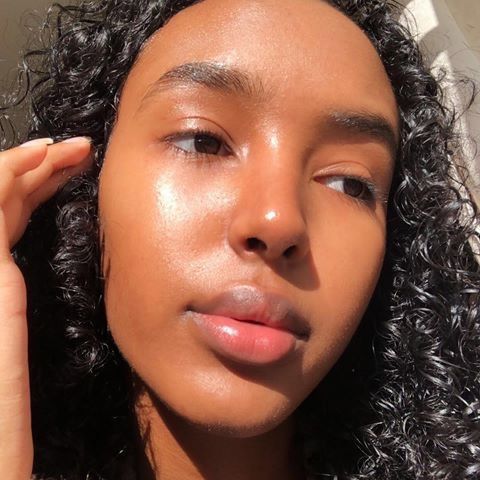
Purging might sound like the title of a horror movie, especially when it’s somehow associated with the purging that happens when a person’s system rejects their food after eating through vomiting or excessive bowel movements.
In skincare, purging is different.
Skincare purging is actually an early sign that a product is working as it should and shouldn’t be confused to mean a product isn’t good for you.
Yes it may freak you out at first, but skincare purging is your skin simply adjusting.
But how do you tell the difference between a breakout and a purge?
What Is Skin Purging?
Skin purging refers to the skin’s reaction to the introduction of certain new class of skincare ingredients to your routine that boosts the Skin cell’s turnover.
This reaction although annoying, is completely natural and normal when using some active ingredients (More details on the exact types of ingredients that could purge later)
In other words, your skin is both producing new cells and shedding dead skin cells at a faster rate.
This causes all the oil, bacteria, and grime under the surface layer of your skin to be brought to the surface sooner than usual so as to give way and clear road for those healthy clear fresher skin cells you want to appear.
This is what’s not so glamorously known as “skin purging.”
So, when you are hoping for a product to clear up your acne, and next thing boom a whole bunch of new blemishes appears instead as though the whole thing is getting worse instead of better. It is simply acne that would have appeared on its own eventually whether you used the new product or not, but your new skincare product is quickly “purging” or expelling them to the surface.
However, the good news is purging is short-lived as compared to your typical acne breakouts.
A regular breakout is when your skin is reacting because it’s sensitive to something in the product. It could be clogging your pores, or causing an allergy, or just plain old irritation or you might have started too many new products at once. Continuing with the product will just make the situation worse.
If your skin is purging, you need to keep going.
If your skin is reacting with a breakout, you need to stop using the product.
What Skincare Ingredient Causes Purging?
Products or ingredients that increase your cell turnover, cause your skin to exfoliate, and bring congestion to the surface are known to cause purging.
Because a purge tends to encourage speed up in the skin exfoliation process, often, you’ll notice what may be minor acne symptoms. The ingredients that lead to skin purging promote skin cell renewal by exfoliating. Generally, it’s said that the skin renews itself approximately every 28 days, but these active ingredients will speed up that process, which can result in temporal uptick in acne activity that serves as a process of the skin cleaning out it’s pipes.
These Active ingredients Include:
- Alpha Hydroxyl acids like Glycolic acid, lactic acid, Mandelic acid, citric acid, Malic acid and tartaric acid which you’d find a good mix of in Neutriherbs AHA Serum
- Salicylic Acid in Salicylic acid cleanser, Salicylic acid serum or salicylic acid clay mask can cause purging because it goes deep to clear out pores.
- Retinoids in Neutriherbs Retinol serum and Pro Retinol Cream, because it encourages skin cell turnover.
- Fruit enzymes like in Neutriherbs Vitamin C Brightening Sheet Mask, but stick with it and you’ll see results ultimately.
- Physical exfoliants like face scrubs.
- Microdermabrasion and chemical peel procedures.
Remember, purging is a good thing. It’s bringing all the pore-clogging stuff to the surface so you can whisk it down the drain.
The key is to find products that are right for you. If your skin is irritated, cut it out.
But if you’re purging, stick with it. Don’t mind what anyone says, just block your ears, literally forget about your face during the period and Trust the process.
How to tell the difference between purging and regular acne?
A breakout on your skin after introducing a new product may not be the sign of a purge, but could be a standard breakout, and there are a couple of things you can keep in mind to help you spot the difference.
Duration
The first sign to look out for is the duration of the breakout. The life cycle of the acne (that occurs during a purge) is faster than a regular breakout. It will heal much quicker than in a typical breakout. If you start a new product that is known for purging, but the breakouts are lasting longer than 4-6 weeks, then it may signal the product is not working for you or actually making things worse.
Location of acne
Purging will likely occur in places you normally get acne (for instance, oil-prone spots like your forehead, chin, nose, Tzone) so if they are appearing somewhere totally new on your face, it might not be due to the purge.
Active Ingredients
Another thing to keep in mind when navigating whether your skin is purging or breaking out is the active ingredients in the product you’re applying to your skin. Skin purges typically result from chemicals that exfoliate your skin, like retinols, alpha hydroxyl acid like glycolic, citric, mandelic acids and beta hydroxy acids such as salicylic acid as well as acne fighting ingredient - benzoyl peroxide. So, if your skin is breaking out after using something like a hydrating oil, sunscreen, or something that can clog pores, like a comedogenic makeup formula, you likely have a traditional breakout on your hands rather than a purge.
Post Breakout Blemish
Purging pimples do not leave marks or blemishes on your skin. It actually heals the skin to form fresher skin cells. Breakouts don’t benefit the skin, they leave marks and blemishes when they go.
Cell turnover rate
The cell turnover during purging is faster to remove dead cells. Purging can last for anything from one or two to six weeks. Breakouts can last a long while; there is no time period that indicates when the breakouts will go away. The cell turnover speed is usual.
The Spread
Purging appears uniformly all over the face. In a breakout, the appearance of the acne and blackheads can be concentrated on any area of the face.
PRO TIPS #1: Purging should also not be confused with an allergic reaction. An allergic reaction will look red, bumpy, scaly and they are classically itchy. “Itchiness isn’t a common characteristic of purging.
PRO TIPS #2: A reaction to a cream or serum applied could manifest as a rash, but it doesn’t outrightly mean you are allergic to the product. It usually happens when you use an exfoliant that lists retinol as an ingredient or when you use some types of vitamin c. In such cases reducing frequency to a minimum so your skin acclimate would be great idea.
WHAT SHOULD YOU DO IF YOUR SKIN IS PURGING?
While it is not possible to control the process, You can stop the process or it’s intensity by stopping using your new product or using it less or using it along side a gentle cleanser and a hydrating serum or moisturizer.
It’s really sad, depressing and discouraging when you experience purging after spending so much on products that promised you amazing benefits. You may feel like completely stopping the products, but please don’t.
Once you’ve determined with your skincare advisor that the reaction is due to purging and not another issue, the best thing to do is to stick with it. For 99 percent of people, it eventually makes your skin look better guaranteed. Though purging can be annoying, the benefits can go a long way if you stay patient.
When you are trying a new routine, you may stick with one new active ingredient at a time so your skin does not go haywire. Also, consider lowering the strength of the active ingredient to lessen the harshness of the purge.
HOW LONG DOES IT TAKE FOR THE SKIN TO PURGE?
In most adults, It may take about three to four weeks for your skin to purge and subside.This is because the skin usually takes 28 days for cell turnover. However this rate slows down as you age. You may start experiencing purging by the second week. But then, these symptoms are temporary and reduce within a month or at most 6 weeks depending on your skin type and genetics.
It’s like a detox program — your skin looks like it’s getting worse before it gets better. It is not actually worsening your acne, though it may appear that way. Depending on the strength of the product and the individual person’s response, purging can even happen the same day as when you use a new ingredient.
If your skin doesn’t clear up after 6 weeks, it is recommended to consult a specialist as it might be a bad reaction to the product.
CAN YOU PREVENT SKIN PURGING?
Say you have a new product you feel may improve your skin, but you don’t really want to deal with the skin purge aftermath that comes with it. Is there anything that can be done to prevent a purge? Unfortunately, not really.
But we recommend slowly introducing a new product into your routine to give your skin some time to adjust.
Introduce an active ingredient gradually. Let's take Retinol For example, during the first week, apply the retinol once a week. “Then for 2nd & 3rd week, apply it 2 times that week, then 3 times a week for 4th to 6th week until you're using the product every night or every other night (depending on how sensitive your skin is).
This will allow the skin to gradually adjust to the ingredient.
You can follow the same pattern with exfoliating acids such as AHA & salicylic acid; just be sure to start with once-weekly application, and don’t exceed two to three times per week at the most. (Any more than that could lead to over-exfoliating)
This technique doesn’t apply to chemical peels, however. Those shouldn’t be used more than once a month, tops.
Treating a Skin Purge Vs a Breakout
You may not like the answer, but the best treatment for purging is to wait. Depending on your skin, it may take about two to three to six weeks for the purge to settle.
Meanwhile, you can treat the skin the same way you would during a breakout, including:
- Use your skincare products slightly less than the recommended amount.
- Stretch out the time between the applications of actives. Space the usage. Don’t use them consecutively but alternately. Include products in your skin care regimen that can be used every second or third day before turning back to actives again.
- Avoiding touching your face or picking the pimples
- Don’t stop using the product and be consistent in using it.
- Avoid picking off the skin or popping out your pimples. These actions promote the spread of acne-causing bacteria to other parts of your face. They also increase the risk of scarring and hyperpigmentation.
- Use gentle and soothing products with ingredients like hyaluronic acid, hemp seed oil, Niacinamide, ceramides etc whenever possible to heal, replenish and restore.
- Hydrate your skin using 4D Hyaluronic Acid Gel moisturizer.
And before you choose a new product, always take a good look at the ingredients and compare notes with other products that haven't worked so well for you in the past—your skin just might not be compatible with a certain chemical or component and that's fine you could simply opt for alternatives to that. There are a few active ingredients that can be an issue for some people, like chemical sunscreens, benzoyl peroxide, salicylic acid, that will always be a problem for them, no matter the formulation or brand.
Wearing makeup is not off the table, but when possible, try to give your skin a chance to breathe. If you want to wear makeup during a purge, keep it to a limited amount and use oil-free face products.
Is Skin Purging a Good Thing?
Purging is neither good nor bad. It can happen after using excellent products. However, it’s a sign that the newly-introduced products are working.
In some cases, skin purging can occur if the skin barrier is compromised before starting to use a product. In such cases, it’s a good idea to repair the barrier function first and gradually introduce the product.
Post-purging is definitely worth the wait for your ideal skin
As annoying as it can be, this pesky purging period will all be worth it once your skin has adjusted to its new routine.
What Happens After Skin Purging?
The end of skin purging is a beauty. It’s the ushering in of brighter, clearer, and smoother skin once your skin had adjusted to it’s new routine.
If only you knew that clear, fresher and much more beautiful skin was waiting just beneath the surface of the whole breakout purging thing then you’d just stick to the treatments all through with single minded devotion.
In Summary
When your skin is going through a purge, don’t control or try to stop it. It is actually good for your skin as the process is removing all the excess dirt and bacteria lodged in the inner layers of your skin. But, it makes sense to know whether it is a purge or a breakout so you can adjust solutions accordingly.


